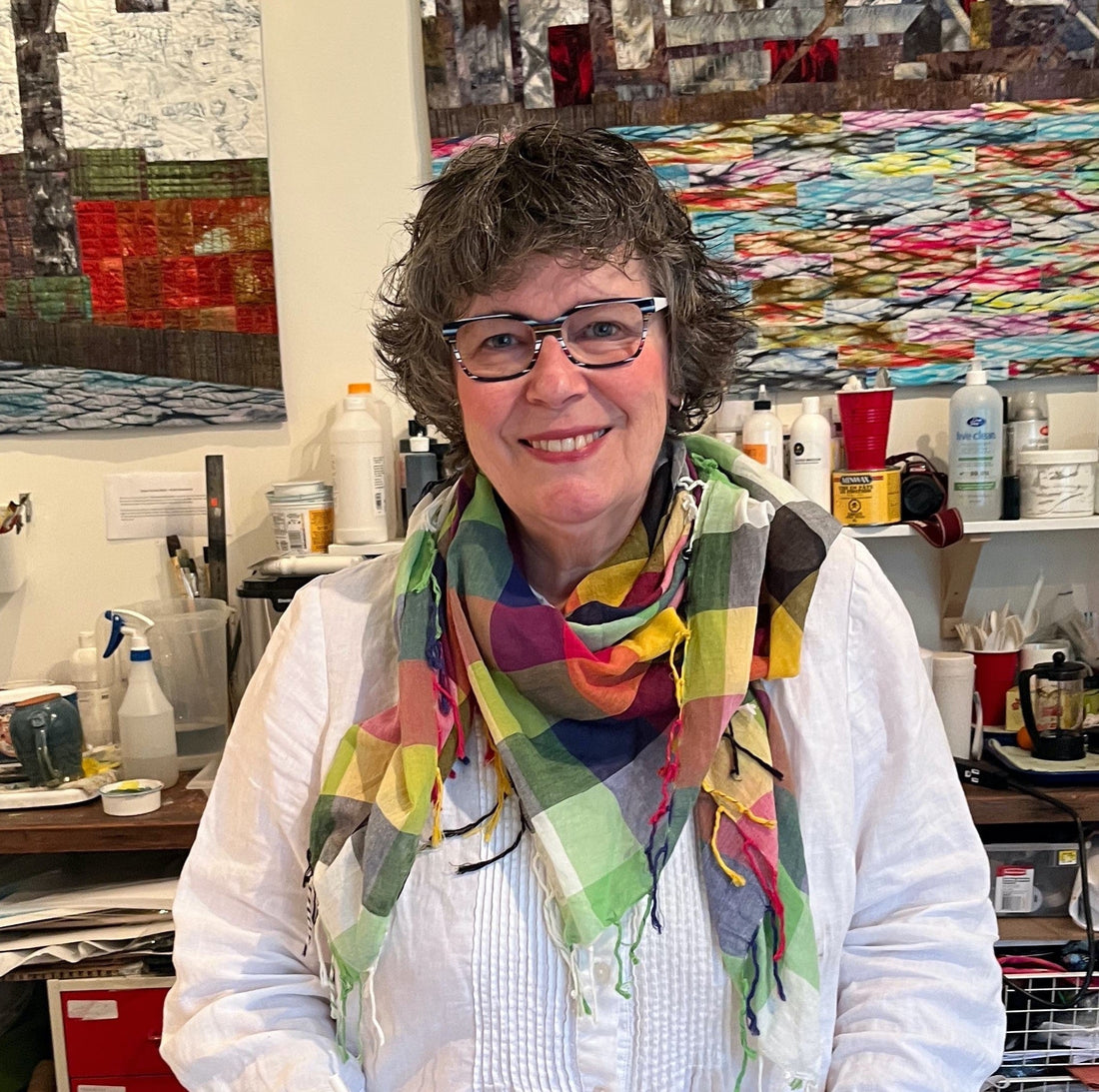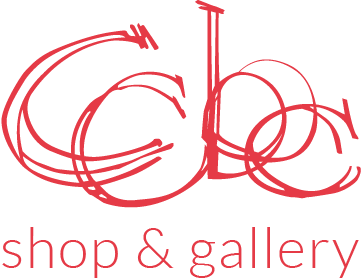
ccbc's artist interview series with susan purney mark
Share
The CCBC’s Artist Interview Series is published on the 15th of each month. Our intention is to connect readers with the incredible artists in our space, consider craft through the lens of an artist, and encourage people in their own journey with craft.

Artist Biogarahy: As a textile artist, Susan has embarked on a life transforming journey into the world of colour, design and pattern. Working with textiles has become her method of self expression and the focus of her methods of communication. Influenced by an extensive study of line and pattern, Susan is now focusing on combining mark making and stitch in both book forms and wall quilts with an emphasis on a controlled palette. Additionally, Susan creates a variety of dimensional objects suited for gifts and home décor. She has studied Design, Patchwork and Embroidery with the prestigious City & Guilds Institute of London, England and has studied with internationally acclaimed teachers/quilt makers Nancy Crow, Jan Meyers Newbury, Elin Noble, Gail Harker and Ruth Issett. Susan has also been awarded two Certificates in Art and Design and Textile Design/Decoration from the Gail Harker Creative Studies Centre in Washington, USA.
Could you tell us briefly what you make?
Excited by applying layers of dyes and paints to achieve interesting pattern and texture to the surface of fabric, I have been creating both contemporary wall and dimensional work since the early 1990’s. I grew up in a home where needlework and sewing were both worn as clothing and decorative. Rooted in my family's needlework traditions, my creations have evolved from functional to pioneering, embodying experimentation, exploration, and experiential processes. I have a diverse art practise, not flitting around but more taking time to explore a certain technique or style, learning how it might influence my work and incorporating into a new series or makes notes and perhaps returning to that technique later on. Somewhat like building a library of knowledge to draw from when I am puzzling out a way forward.If you peek into my studio, one wall is devoted to a series of monoprinted cityscapes inspired by a volunteer stint in Spain two years ago. Another wall has some work that I’ve been exploring of paper and fabric collage with stitch that looks at the coves and bays of our Salish Sea. Another wall is empty as the artwork is being shown in a gallery.
returning to that technique later on. Somewhat like building a library of knowledge to draw from when I am puzzling out a way forward.If you peek into my studio, one wall is devoted to a series of monoprinted cityscapes inspired by a volunteer stint in Spain two years ago. Another wall has some work that I’ve been exploring of paper and fabric collage with stitch that looks at the coves and bays of our Salish Sea. Another wall is empty as the artwork is being shown in a gallery.
 rooted in a hands-on, material-based practice. Textiles have a softness and familiarity that can draw people in, creating space for reflection and dialogue. Whether through personal storytelling or broader social themes, my work continues to evolve as I respond to what feels most urgent and relevant. In addition, I like to set some time aside to address what I term “call and response” …I see something on YouTube or at a show or in a dream or a new art item…it’s probably not going to develop into a finished piece but I just want to try it out. It calls to me and I respond, put it into my sketchbook with some notes for later reference.
rooted in a hands-on, material-based practice. Textiles have a softness and familiarity that can draw people in, creating space for reflection and dialogue. Whether through personal storytelling or broader social themes, my work continues to evolve as I respond to what feels most urgent and relevant. In addition, I like to set some time aside to address what I term “call and response” …I see something on YouTube or at a show or in a dream or a new art item…it’s probably not going to develop into a finished piece but I just want to try it out. It calls to me and I respond, put it into my sketchbook with some notes for later reference.
layers that feels both grounding and freeing. A brushstroke on canvas is a moment, but a stitched line can be built up, changed, unpicked, and reworked, holding a history of decisions. That process is just as important to me as the final piece. Another thing I love is how textiles blur the line between art and function. A quilt can be a work of art, but it also brings warmth. A hand-stitched piece can be displayed, but it can also be touched, folded, and carried. That kind of versatility makes textiles unique. They don’t just sit on a wall; they live with us.
 The tactile nature of craft keeps me coming back. There’s a rhythm to stitching, a flow to weaving, a sense of movement even in stillness. Whether I’m layering marks on fabric, working into surfaces with stitch, or experimenting with dye, I’m in conversation with the material. It’s not always predictable, but that’s part of the joy.
The tactile nature of craft keeps me coming back. There’s a rhythm to stitching, a flow to weaving, a sense of movement even in stillness. Whether I’m layering marks on fabric, working into surfaces with stitch, or experimenting with dye, I’m in conversation with the material. It’s not always predictable, but that’s part of the joy.
Ultimately, I make craft because it allows me to connect—with myself, with others, and with the long tradition of textile makers before me. There’s something deeply human about working with our hands, about creating something out of raw materials. It’s not just about the finished piece; it’s about the making, the process, the time spent. That’s what keeps me coming back.
I remember going to an embroidery exhibition years ago and realizing that stitched work didn’t have to follow a pattern or set of instructions. That idea stayed with me—the thought that embroidery, like any other art form, could be a space for creativity and experimentation. It was something that could be learned and developed over time, not just a skill to follow step by step. A little later, I joined the London City and Guilds programme for Embroidery and Patchwork. It was more than just learning stitches; it had a strong design focus, covering colour, line, form, and texture. Alongside the technical skills, this gave me a new way of seeing textiles—not just as fabric and thread but as a medium for expression. I hadn’t planned for it to become a career, but one thing led to another, and I found myself working professionally, mainly in quilting. Teaching and writing about surface and pattern design also became part of my practice, allowing me to share what I had learned with others. More recently, I’ve been drawn to dimensional work, particularly in my *Vessels* series, where I explore shape and structure in textiles. Alongside that, I continue working with collage, paper, and paint, always looking for new ways to bring different materials together. The process of
 making has taken me in directions I never expected, and that’s what keeps it exciting.I also devote a lot of time to teaching, before Covid I was on the road a lot, traveling to different guilds and festivals. Now most of my instruction takes place online – Zoom lectures and developing workshops in different techniques plus a mentoring programme keeps me in touch with textile artists around the world.
making has taken me in directions I never expected, and that’s what keeps it exciting.I also devote a lot of time to teaching, before Covid I was on the road a lot, traveling to different guilds and festivals. Now most of my instruction takes place online – Zoom lectures and developing workshops in different techniques plus a mentoring programme keeps me in touch with textile artists around the world.
To an emerging or young craft artist, I’d say: focus on building your community. Skills will develop with time, practice, and dedication, but having a strong network of fellow artists can make all the difference. Connect with others who share your interests—join local groups, attend workshops, and participate in exhibitions. Conversations with other artists can spark ideas, offer guidance, and provide the encouragement needed to keep going.Engaging with a creative community isn’t just about learning from those with more experience; it’s also about sharing your own knowledge and perspective. Ask questions, offer support, and collaborate when opportunities arise. Whether through online forums, artist meetups, or informal studio visits, these connections help build confidence and open doors.Making art can sometimes feel solitary, but it doesn’t have to be. Surrounding yourself with others who understand the challenges and joys of craft can keep you motivated and inspired. Your community will grow with time, and as it does, you’ll find that supporting others strengthens your own practice.
Are there ideas, values, beliefs, or concepts that your work communicates? Could you tell us a bit more about that?
 “discovery”, “new” or “revolutionary”….but then I’m a bit confrontational!I would like my work to stand some sort of “test of time” but it is continually expanding and improving – I don’t hang onto the past, but acknowledge that it has given me the foundation for moving forward. I want my work to underscore the value of craft and to be seen as “soul” work.My favourite quote is by T. S. Eliot - We shall not cease from exploration. And the end of all our exploring, Will be to arrive where we started, And know the place for the first time.For me, the journey is in the exploring…
“discovery”, “new” or “revolutionary”….but then I’m a bit confrontational!I would like my work to stand some sort of “test of time” but it is continually expanding and improving – I don’t hang onto the past, but acknowledge that it has given me the foundation for moving forward. I want my work to underscore the value of craft and to be seen as “soul” work.My favourite quote is by T. S. Eliot - We shall not cease from exploration. And the end of all our exploring, Will be to arrive where we started, And know the place for the first time.For me, the journey is in the exploring…
website | instagram | ccbc
